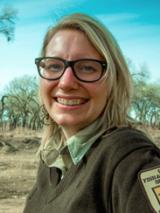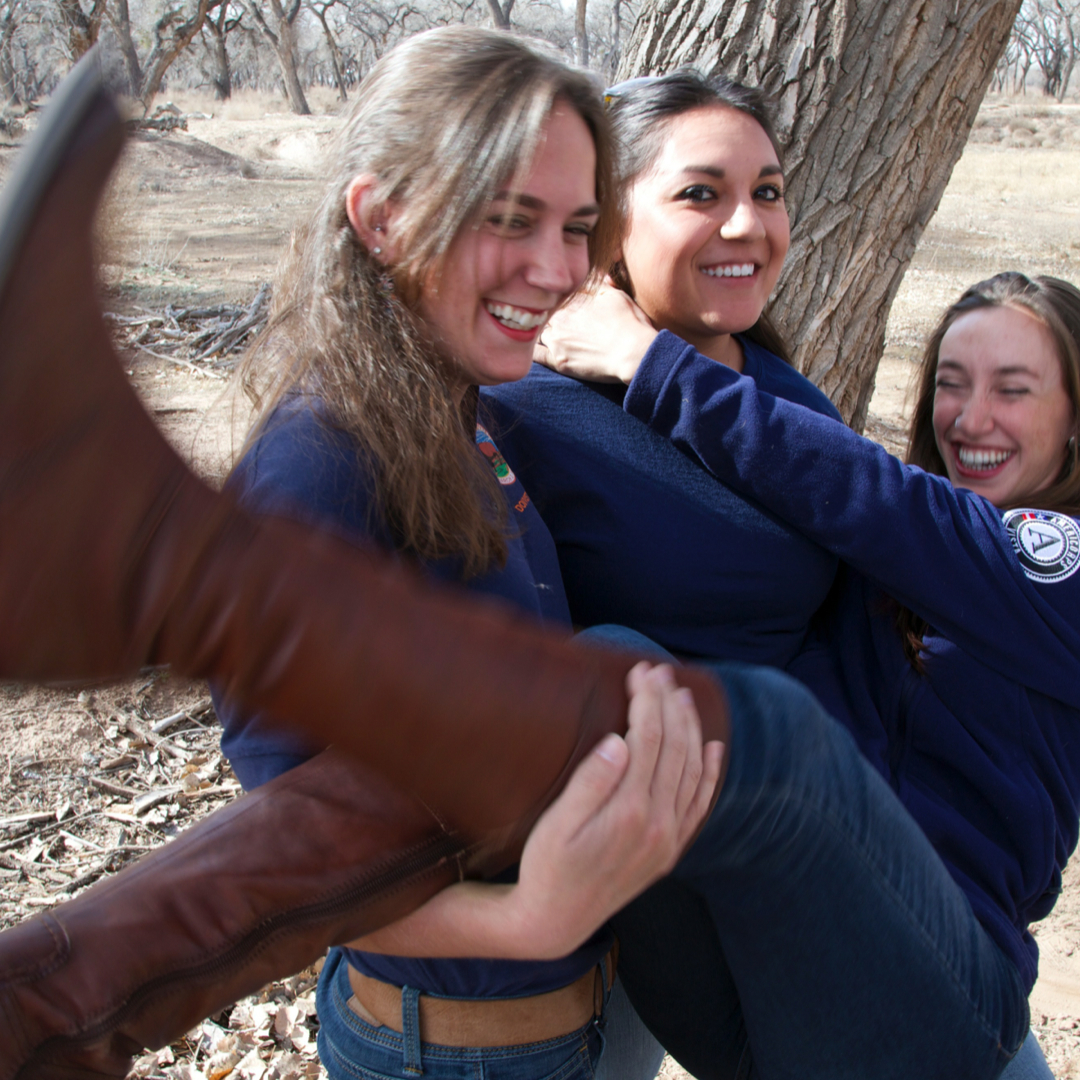
Newsletter
Sign up and stay in-the-know about The Crowd & The Cloud and the world of citizen science.


I’m Jennifer Owen-White and I’m the Manager of the Valle de Oro Wildlife Refuge in New Mexico. My job is to put the community’s amazing ideas together with sound science and engineering to create something that is sustainable for wildlife and people.

Bird's eye view of the Rio Grande.
What makes the Rio Grande so important to the Valle de Oro Wildlife Refuge?
The river is really critical to Valle de Oro, especially because the river itself used to come right through the refuge property. At one point, when there was a large snow melt in the spring, a huge flood came down, and the river jumped its banks to where it is now. When we're thinking about restoring habitat on Valle de Oro, we think about what would have happened in that space where the river was. We think about all the little divots and topography that would have been created by the river, and how that would have turned into seasonal wetlands that would provide for a diversity of wildlife. We think about restoring habitat in terms of what would have been here naturally. Knowing that this river used to be on our property and would have created the great diversity of plants and animals, is something that we want to get back to.
How has human settlement had an impact on the river?
We are in the desert Southwest, and wherever there is water that's where people want to be. People started settling here, in the Albuquerque area, and realized that there was an issue when the river flooded because it started to flood the old Albuquerque town site, where people were living. The people here decided that we need to control the river and keep it within its banks. A lot of things were done, like putting in levees and dams, and installing “jetty jacks”, which are the large metal X's that catch debris. When we did that, we inadvertently changed the way this ecosystem works. We kept the river from flooding, but that flooding was what created this beautiful cottonwood forest. Without that flooding, when these cottonwoods drop their seeds they don't have moist soil to germinate in.
Is there anything related to the water in the river that the citizen scientists are monitoring?
With Nature's Notebook, we monitor the cottonwoods. We're learning about when they are budding, when they're dropping their seeds, and that's going to help us when we re-create flooding events. We can re-create flooding events at the exact right time so that when the cottonwoods drop their seeds, they germinate. That way we don't have to plant hundreds of cottonwoods, they grow on their own. We also have other projects that we've linked with Nature's Notebook, like the Bosque Ecosystem Monitoring Program (BEMP), where they're studying the water levels in the river and the groundwater, which is going to help us with restoration. We put that together with the information about the wildlife that we create with Nature's Notebook, and it gives us a better picture of what's happening out here, and how we can work with what's naturally going on to re-create an amazing habitat for wildlife and people.

Cottonwoods in the Valle de Oro Wildlife Refuge.
What was the land used for before it became the Valle de Oro Wildlife Refuge?
Valle de Oro used to be the Price's Dairy and Valley Gold Farms, and that's where we get the name Valle de Oro. It was actually a community generated competition to name the refuge, and Valle de Oro was what won because it really speaks to the Hispanic heritage of the land. This was a dairy farm from the 1940s through to the 1970s, and then they took the cows off the property and continued to farm it for hay, grasses, and alfalfa, which is still going on today. In 2012, we were able to start the land acquisition to make this the first urban refuge in the Southwest. We were able to do that because of the passionate, involved community members who knew this land was going to be for sale, and who fought hard to make sure it was protected. Because the community members were so worried about things that would move in that could be detrimental to their air quality, water quality, or soil quality, they fought hard to make it something positive for their community for generations to come. That's how we got a National Wildlife Refuge here.
What makes the Valle de Oro different from other refuges?
Valle de Oro is a little bit different than your traditional National Wildlife Refuge, because we are a refuge that's established for helping urban audiences, especially youth, connect with nature and the outdoors. Our main purpose is to help kids, their families, and urban community members, understand conservation, and how they can be a part of it. Valle de Oro is the Southwest's first urban National Wildlife Refuge. It's urban because 40% of the entire population of New Mexico lives within 30 minutes of this place, and 70% of the population can be here within 90 minutes.
In 2010, the National Wildlife Refuge system underwent a visioning process called "Conserving the Future," where we started to think about how we were going to move forward in the next 10 to 15 years, and how we were going to remain relevant to a changing America. A big part of that was the Urban Refuge Initiative. It was the first time that the US Fish and Wildlife Service and the National Wildlife Refuges, really set forth to reach urban audiences and engage people in enjoying the outdoors, enjoying wildlife, and being involved in citizen science. It's the first time we set out to create places specifically for people interacting with the environment, and being a part of conservation. We can help create a connected conservation constituency. Our ultimate responsibility is about providing a safe place for people of all ages, all backgrounds, and all ability levels to connect to the outdoors and learn about science.

Volunteers and staff get ready for a photo shoot.
Would you have any other means of getting the data you’re collecting if you didn't have these volunteers?
At this point, we really wouldn't have any other way of getting this data. I started out as a one person staff. I now have one additional staff member as an education specialist, but we don't have a biologist assigned to the refuge. I'm a biologist, but I also get to do most of the administration, and it’s a lot of work.
If it wasn't for these citizen scientists, we wouldn't be getting all of this great data. We wouldn't actually know if our predictions are right about how our restoration is going to have an impact, we'd never be able to analyze that. It's because of the citizen scientists that dedicate their time and passionately work on this project, that we can gather really great information that'll guide us through our restoration. It's going to make us more efficient, and help us work faster in restoring the habitat, and work smarter.
Which species of trees are you focusing on?
We study two species of trees, the Rio Grande cottonwood and the Siberian elm. The Rio Grande cottonwood is what makes up the beautiful bosque forest. They're tall and winding, they produce beautiful leaves, and in the fall those leaves turn a beautiful color of gold, which gives our refuge, Valle de Oro, it's name. They are very special to this ecosystem, and special to the people of Albuquerque.
On the other hand, we have the Siberian elm that grows everywhere. They produce bright green leaves and flowers, intrude in habitats where you don't want them, and threaten this beautiful bosque. They threaten a lot of the habitat restoration that people are working hard for.

Many volunteers come from nearby Hispanic and Native American communities.
How does your work involve the National Phenology Network?
One of the most exciting things is that the data we collect here isn't just used for Valle de Oro. It goes into a national database, and scientists and educators all across the country can access this data. Because of the hard work of the National Phenology Network, we actually have a phenology trail here along the Rio Grande. With their help, we selected about a dozen birds to study on the refuge. We can compare our data with what they have just a little bit further up the river from us, and then people in other states can look at that information. It's really neat to know that what we're learning here can add to larger data sets, and help with research on all sorts of things like climate change. Also, we have very limited staff here, and so having them work with us to create materials, lead webinars, provide educator information to help us engage our volunteers, has been really important to the success of our program.
What kinds of people volunteer at Valle de Oro?
We have a great diversity of volunteers, which is something we want to encourage with the refuge in general. We have high school students from the Nex+Gen Academy, who helped us establish this site. They helped us pick where we were going to study, write and refine protocol, and gather information about the species. They were really instrumental in getting this project started. We have our High School Youth Conservation Corps members who work with us in the summer, as well. They actually get a job working for the refuge in the summer time, and part of their job is to collect Nature's Notebook data. Then, we have community members who want to be involved. Retired teachers, recent biology graduates, even astronomers, all kinds of different people who just like being outdoors.
I'm so grateful for all of the volunteers who give their time and their energy to collect this data. It's not easy, it's not quick, and this is a mutually beneficial relationship where the volunteers are learning more about wildlife and plants in their community. Most importantly, they feel like they're giving back to something big, and something special. It feels good to them that their data is being used to restore a National Wildlife Refuge. They're not just out there collecting data, entering it, and if they see something, noting it. They get to come out here, and they get to experience how their data is being incorporated into the refuge designs.

Nex+Gen Academy students contribute invaluable phenological data using Nature's Notebook.
How important is community involvement for Valle de Oro?
Community involvement is at the center of what Valle de Oro National Wildlife Refuge is all about. Not just the citizen science part, but citizen involvement in every aspect, including the designs and environmental education pieces, and starting off with the land acquisition. The community members formed “Friends of Valle de Oro”, before the refuge was even established. We had a group fighting for us, making sure that this was going to happen. When it came to the land acquisition, a full 50% of the funding came from outside of the federal government. From non-profit organizations that have a small budget to start with, and they gave what seems like a significant portion of their operating budget to help build this National Wildlife Refuge.
